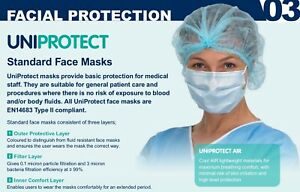
EN 14683
This standard is intended to help facilitate the choice of surgical face masks in the European Market by standardizing the information and performance data required for the masks.
There are three test methods used to classify surgical masks:
1.Bacterial Filtration Efficiency in vitro (BFE) (ASTM F2101-07)
Test is used to determine the amount of infective agent that is retained by the surgical facemask, which is directly related to the amount of bacteria released through the mask into the air of the surgical theatre.
To test, a controlled flow of air containing an aerosol with a controlled concentration of Staphylococcus aureas is driven through a sample of the surgical mask containing all layers. The average size of the aerosol droplets is around 3.0 Micron. The number of bacteria that passes the sample is compared to the number that passes without the mask sample.
A higher BFE percentage indicates a better protection level for the patient against infective agents from the OR staff.
Classification:
BFE => 95% TYPE I
BFE => 98% TYPE II
A different BFE test called the “Modified Green & Vesley” or BFE in vivo has been used frequently in the past. This test method always provides extremely high values, but does not really differentiate between different quality surgical facemasks. The BFE in vivo test method is therefore not part of the new EU standard.
2.Breathing Resistance (Delta P)
Test is used to determine the resistance airflow of the facemask.
To test, a controlled flow of air is driven through a sample of the surgical mask containing all layers. The pressure before and after the sample is measured; the difference in pressure is divided by the surface (in cm2) of the sample.
A lower breathing resistance indicates a better comfort level for the user. It means the mask feels cooler and easier to breath through, and that the mask will maintain its shape in a better way as there is less pressure on the material. There will be less unfiltered air escaping around the mask.
Classification:
TYPE I & II (non splash resistant) = < 3.0 mmH2O/cm2
TYPE IR & IIR (splash resistant) = < 5.0 mmH2O/cm2
The breathing resistance is always measured per square centimeter of material. One way to increase comfort is to have a low breathing resistance value per cm2, the other to enlarge the surface of the facemask and thereby the total area available for ventilation.
3.Splash Resistance (ASTM F1862-07)
Test is used to determine the resistance penetration of potentially contaminated fluid splashes.
To test, a precisely determined quantity of specially prepared artificial blood is sprayed at a controlled pressure against a sample of the mask. Frequently these tests are done at pressures of 80, 120 and 160 mmHg. A visible inspection on the backside of the sample indicates if there is a fluid strike-through (red color) or not. The test is repeated 32 times at each pressure, and if three or less masks show a strike through, the product is considered splash resistant at that pressure.
A higher splash resistance means the mask will protect the user in a better way against splashes of potentially contaminated fluid during a surgical procedure.
Classification:
TYPE I & TYPE II not applicable
TYPE IR & TYPE IIR minimum 120 mmHg
120 mmHg is a minimum value. It corresponds to the average systolic arterial blood pressure, and intends to protect against ruptures in small arteries causing small sprays of blood. Some products off protection even in excess of the 120 mmHg.
Minimum Performance Requirements According to the New Facemask Standard EN14683
EU Standard Class
Bacterial Filtration Efficiency
Breathing Resistance (mmH2O/cm2)
Splash Resistance (mmHg)
I 95% < 3.0 NA
IR 95% < 5.0 120
II 98% < 3.0 NA
IIR 98% < 5.0 120